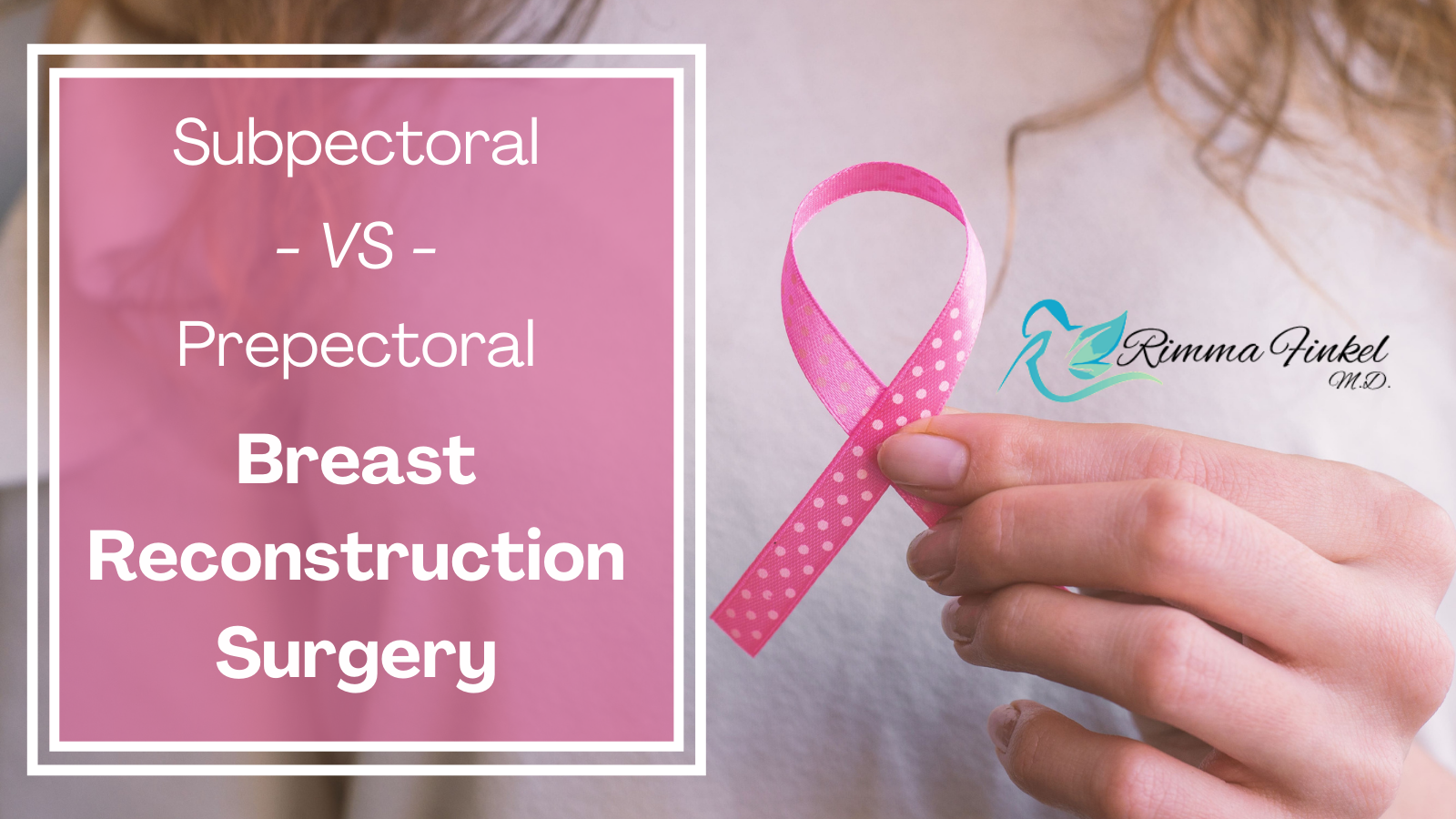
Breast reconstruction is a procedure designed to reconstruct the previous breast shape and replace the breast tissue that is lost during either mastectomy or lumpectomy. The main goal of this procedure is to form breasts that are going to be as close as possible to the original appearance and shape. The procedure either begins at the time of mastectomy or is delayed for later. Although women are more prone to this procedure due to breast cancer, there are multiple male counterparts doing the same on a yearly basis. Breast cancer is much more prevalent in females (1 in 8 women in the US) than in males (1 in 833 in the US). That’s why it’s so important to learn about the differences between subpectoral vs prepectoral breast reconstruction surgery.
There are many factors that play a role in deciding which type of breast reconstruction is suited for the patient. Some of these include the patient’s medical history (possible ongoing cancer treatment & type of mastectomy), physique, and desired implants. However, this procedure is completely optional. There are two ways to perform breast reconstruction and it’s imperative to learn the differences and which option suits the patient’s needs.
Subpectoral vs Prepectoral: Which One Suits Me The Best?
The most important step before proceeding with breast reconstruction is to decide whether you need a subpectoral or prepectoral breast reconstruction surgery. The most common procedure is subpectoral, although there’s still a lot of need for prepectoral breast reconstruction surgery. We always advise our patients that breast reconstruction is a process that might include multiple surgeries, revisions, and most important of all, time. Not everyone is the same. You’ll have to consider your personal needs and consult your doctor before proceeding with either of these options. And keep in mind, breast reconstruction surgery does not put you at risk for breast cancer recurrence.
One vital aspect of considering breast reconstruction is choosing well-qualified and experienced surgeons. It’s important to be properly prepared for the procedure. Dr. Rimma Finkel, MD, is a double board-certified plastic surgeon. As one of the only female physicians in the city of Phoenix and the surrounding area, Dr. Finkel offers a unique view to her patients and always acts in a patient’s best interest. Come in for a consultation if you’re thinking about breast reconstruction. All of us deserve to be fully confident in our bodies.
Subpectoral Breast Reconstruction Surgery
Also known as submuscular or under-the-muscle implant placement surgery, this is a traditional method of doing breast reconstruction surgery. During this type of breast reconstruction, the pectoralis major muscle is elevated from the chest wall, and the surgeon will place the implant behind this muscle.
This type of surgery is a two-step process. During the first step, to reach the desired volume, surgeons insert a tissue expander. Before the last step of the procedure—the placement of breast implant—the patient must return to exchange the tissue expander.
Benefits of Subpectoral Breast Reconstruction Surgery
- Studies have shown that women who had subpectoral breast implants are less likely to develop capsular contracture, a painful condition that occurs when scar tissue forms around the implants.
- In patients with less soft tissue padding, this kind of implant can appear more natural when compared to prepectoral implants.
- Subpectoral implants reduce the risk of rippling. Rippling is when patients can see their implants through the skin.
- For those seeking a breast lift, it’s a much safer choice.
- Muscle supports the placement of the implant so there’s a significant reduction of wear to the skin.
- Mammograms are less distorted.
Disadvantages of Subpectoral Breast Reconstruction Surgery
- Recovery is much more uncomfortable. It takes longer for the breasts and swelling to settle.
- When working out, the muscle flattens the implants and pushes them out, changing the shape of the breast. This can lead to a distortion of the implants.
- Until the muscle fully relaxes, the breasts might seem to sit a bit high.
- The procedure is considered more difficult and perceived as more invasive.
- You might see an indentation over the implant.
- Possibility of a double-bubble deformity.
Prepectoral Breast Reconstruction Surgery
Prepectoral reconstruction is a new method used in the breast reconstruction field. Surgeons place the implant above the pectoralis major muscle. The implant resides directly on the breast instead of underneath the chest muscle. Since a surgeon doesn’t make an incision in the muscle, this method helps the patient with the recovery substantially, as opposed to the subpectoral implant placement. And there’s almost no difference in the end—both methods have a very similar result. However, there are a number of things to consider before choosing this certain method.
Benefits of Subpectoral Breast Reconstruction Surgery
- The procedure is easier to do and less invasive.
- There is less discomfort during the recovery because the muscle stayed intact. However, this should not be a deciding factor.
- In some cases, this method improves the shape and position of the breasts—particularly for women that have mildly sagging breasts.
- Depending on the soft tissue of the patient’s breasts, there are more possibilities for larger implants to be utilized.
- No implant distortion when muscles are flexed.
Disadvantages of Prepectoral Reconstruction Surgery
- Method results in a less natural look—pronounced roundness can also be a personal preference for some women.
- More visible rippling because there’s less tissue covering the implant.
- The implant can distort mammograms.
- Capsule contractions are more likely, as opposed to the subpectoral method.
- The possibility of a successful breast lift is lower.
Seeing how 1 in 8 women in the US will develop breast cancer during their lifetime, this procedure is becoming a more popular option for many women. It’s estimated that throughout 2021, there will be more than 280,000 new cases of invasive breast cancer, as well as almost 50,000 cases of non-invasive breast cancer. Early-stage discovery is key with any type of cancer, whether it’s non-invasive or invasive. Ultimately, the decision for breast reconstruction surgery is up to the patient. The surgeon doctor is there to educate you, and based on multiple factors, recommend what is the best possible option.
Breast cancer survivors need to feel comfortable in their own bodies. Taking the necessary steps to maintain their health and happiness is essential. Dr. Finkel will go over every possibility beforehand. She understands that patients are stressed and some things are a lot to digest at certain points. Start your reconstruction journey today with Dr. Finkel!
Frequently Asked Questions About Subpectoral Vs Prepectoral Breast Reconstruction Surgery
If I get a breast reconstruction procedure, can I be more prone to future breast cancer occurrences?
That’s a common myth among patients that are thinking of getting breast reconstruction. There are zero known studies linking breast reconstruction to a future breast cancer occurrence.
What can’t I do after the procedure?
You can’t take baths or submerge into the water while the drains are in. However, showering while recovering is perfectly fine. Many doctors also recommend limiting the amount of exercise after the procedure.
How long do the implants last?
New gel implants will probably last you a lifetime, although there may be a possibility of future revisions of the implant. We cannot provide a certain guarantee but you can be sure we’ll do everything necessary in case a problem occurs.
How long does the recovery process last?
It depends on the type of breast reconstruction you receive. Recovering from subpectoral reconstruction may take up to a few weeks, while recovery from prepectoral reconstruction is usually quicker.
Can breast reconstruction return the feeling in my breasts?

We always tell patients that they shouldn’t expect a reconstructed breast to recover the full feeling. After a few years, some feelings may return. At the end of the day, it all varies from patient to patient.
Whatever you decide to do, always consult with the best doctors and surgeons. Dr. Finkel is here to help you gain confidence. Specializing in reconstructive and aesthetic surgery of the breast, Dr. Rimma Finkel is a double board-certified plastic surgeon operating out of Phoenix, AZ. She serves patients all over the Greater Phoenix area. Schedule your consultation today online or call our office at (480) 963-3034!

